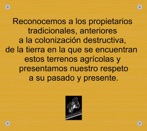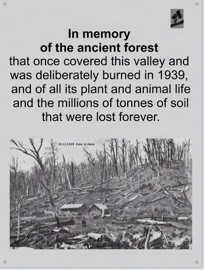
Legal aspects.
Restoring responsibility
Redi’s adage: omne vivum ex vivo ("All life comes from life")



Dura lex, sed lex, “The law is harsh but it is the law”, basic principle of any legal system.
There is no national legislation that protects the decisions of landowners to assign their land to conservation or restoration. Hence the need to develop a custom-fit and workable legal programme for the project.
The result of 18 years of looking for the appropriate legal solutions includes:
I. Features of the project of importance for a legal support:
-
• Private land, private landowners, all laws and legal requirements relevant to private property, apply;
-
• Registered status: agricultural land;
-
• Land and ecosystem severely degraded by brutal colonisation practices in the mid-XX century);
-
• Size of land is not enough to deal with massive external pressures but enough to reverse the negative trend;
-
• No recognition, support or rewards for landowners for land conservation;
-
• Conservation NGOs and similar legal persons dominate the conservation market;
-
• Working in isolation, very little cooperation of private landowners on any issue, no tools for coordination of actions;
-
• Oriented at land and live nature restoration and conservation;
-
• Local farming practices which are degrading and damaging the land;
-
• Local institutional hostility to land restoration;
-
• Choice of the status of a strict nature reserve was imposed by severe land and soil degradation.
II. Main issues and respective legislation-based solutions:
1. As private landowners of agricultural land:
-
• Need to ensure long-term legal protection;
-
• Landowners have a long-term vision, preserving land into the future and knowing its past;
-
• Ownership of the land also includes the right to protect it as custodians of the land;
-
• Protecting the optimal conditions for fulfilling the obligations by the landowners;
-
• Public law does not protect or benefit private landowners, use of civil law and other measures;
-
• Use of civil law for triggering responsibilities, liability under civil law is more effective and
affordable than responsibility under public law.
The main being:
The Law on In rem Right of Environmental Conservation (.pdf), Law 20930 (2016) on Derecho Real de Conservacion (DRC) Medioambiental. This law adapts the concept of real rights (land servitudes are the main example of these rights) in civil law to the need to protect natural features of private land. It’s similar to granting a legal or physical person a servitude to protect agreed natural features of the land, which crates respective rights and obligations for the grantee (the custodian) and the grantor of the right. The “servitude” model provides a certain advantage because of the strength of the rights granted to the servitor, protected by the civil code.
The grantee of this In Rem right in this case is a legal company, a juridical legal person with personal commitment to the issue, due to the main problem to be covered and personal experience. The Land Trust option, quite promoted at present, was not used as the figure of Land Trust is rooted in a common law legislation, completely different from the national jurisdiction which is a typical statutory (civil) law legislation.
The contract concluded in accordance with the law become integral parts of land titles. The rights are In Rem, therefore go with the land, not with the landowner. Conditions of the In Rem right of conservation for land titles of the project are detailed in this document: DR contracts.pdf . The goal is to ensure effective and irrevocable protection of the land, in perpetuity as a priority, providing reliable legal base for future long-term rather than immediate benefits, a protection independent to the maximum from the rapidly changing social environment.
The implementation of the DRC raised the issue of Statutory law vs. Common law jurisdictions.
Other legal measures:
-
• Compensation: compensation claims (advertising the private land in public space, pollution, misrepresentation, illegal use of land, etc.), including to the scientific and environmental non-governmental institutions;
-
• Measures under audiovisual law: cases of “influencers” filming commercials in private land with no authorisation;
-
• Disclaimers’ publication;
-
• Involving other actors, such as tourists, into civil law claiming for damage and compensation due to the non-respect of the legislation. Endangered species get a huge bump when private lands are brought into the conservation.
Barriers in private (not administered privately = by non-State legal persons) conservation:
-
• No access to funding (f.e. GEF) or other direct support;
-
• Effectiveness land protection by private land owners vs. privately protected land is not assessed;
-
• The right to protect as part of right to property - a legal right, individual human right, is seldom recognised;
-
• Different from NGOs management and business models and objectives;
-
• Buying land for conservation/restoration programmes: limitations linked to the questions of viability of these programmes, institutional models of the management of the land, diffuse responsibility for the acquired land, limited experience in hands-on land protection.
In some cases mines are bought to restore them for nature: Fapas (bear protection association in Spain) purchased an open sky coal mine for wetland restoration
Under the national legislation this opportunity is hampered by the the fact that no public property is foreseen in the legislation, therefore public legal persons cannot purchase land for conservation only.
Effectiveness evaluation of the land conservation measures on private land and land managed by public legal persons:
-
• Important for assessing the reality of the land conservation under different regimes;
-
• Should be regular and on the long-term, including assessments of the past of each model;
-
• Use of own criteria.
2. Significantly deficient law enforcement at local level.
To counter this situation the focus is on Restoring the rule of law for a buffer zone of a biosphere reserve:
-
• The land is located in a buffer zone of a UNESCO biosphere reserve Laguna San Rafael.
The park (core area of the reserve) benefits from only a minimalistic protection level;
-
• International recognition of national protected areas has no binding effect under national law;
-
• Restoring the application of legal requirements for a biosphere reserve, the area cannot continue to be a lawless zone.
Statutory Framework of the World Network of Biosphere Reserves (UNESCO):
“Art. 4: It should include functions, through appropriate zonation, recognizing: ... a buffer zone or zones clearly identified and surrounding or contiguous to the core area or areas, where only activities compatible with the conservation objectives can take place. Art. 7: Provisions should be made for ... mechanisms to manage human use and activities in the buffer zone or zones”.
Influence of legal history and legal culture:
-
• Brutal colonisation practices and their legal arrangement of the 1930s-40s;
-
• Present need to prevent ecological amnesia;
-
• Legal history of the valley, disregard of the type of land tenure;
-
• Legal aspects of tourism: tourism law is not developed, and the little of it is not enforced.
3. Minimal legal protection or recognition of land and nature restoration or reforestation:
Absence of recognition by damage to and degradation of the land, of the ecocide of the 1930-40s in the area;
Resulting minimisation of legal tools to foster land rehabilitation and nature restoratio
Reforestation, forest law:
-
• Use of market-based instruments for non-market objectives: natural reforestation, forest-based nature restoration.
-
• Native Forest Law (Law on Recovery of Native Forest and Promotion of Forestry) 20.283
-
• Large and successful programme of native forest restoration, due to nature-based planting protocols and high qualifications of staff;
-
• Compensation forest planting - compensation programmes of large electro-power projects.
-
• A problem: constantly changing interpretation of the Law by its implementing authority - National Forestry Corporation.
-
• Focus on upscaling the importance of legal support to nature and land restoration and rehabilitation, and of legal tools for long-term protection of the successes of restoration.
-
• Present legal arrangements include implementation of national forest law instruments (.pdf), in particular the Law on the recovery of native forest and forest development (Ley 20.283), and relevant management agreements with the National forestry corporation (Conaf), as well as some other legal and guidance instruments, such as Decreto Ley Nº656, Decreto Ley Nº701, National strategy on biodiversity, etc.
Conservation vs. restoration and protection:
-
• No individual species conservation in the project;
-
• In the present case: protecting recovery, not valuable ecosystem;
-
• Conservation of live matter failed globally;
-
• EU court decisions: sites worth restoring can be included in conservation projects.
III. Other issues:
1. Local:
-
• Violations of property rights are common;
-
• Constant misrepresentation of the land and landowners, bordering on identity theft;
-
• Colonial customs are still understood as overpowering legal requirements;
-
• Legal aspects of damage by mass and disrespectful tourism;
-
• Legal aspects of scientific research and expeditions, legal protection from science;
-
• Notion of “community”, if it’s local farmers - not patronising and considering them as main land stewards;
-
• Sharing negative experiences, not only success;
-
• Frequently changing legal and administrative requirements;
-
• No real legal or judicial expertise in the area;
-
• Mining industry and its rights;
-
• Small business’ grants programme: not selective and allows “grant hunting”;
-
• A legal watch programme for local issues was initiated by the project.
2. National:
-
• Land in private property is protected by the present national legislation from use by non-owners.
-
• No national legislation on soil protection.
National legislation used:
-
• Environmental Framework Law 19.300, 1994;
-
• Law Establishing the National System of Wild Areas Protected by the State 18.362, 1984;
-
• Forest Law, Decree 656, 1925;
-
• State Property Rules, Decree 1.939, 1977;
-
• Washington Convention via Decree 331, 1967;
-
• Law on donations 21.440, 2022.
-
• National legislation on large predators .
3. International law and instruments:
The national legislation is of monistic nature and recognises the direct application of international legal instruments (self-executing provisions). The problems the project is addressing are global, nature is destroyed in the same way globally. As the era of globalisation seems to be over, it is important to preserve the legal norms developed to address global problems. Relevant provisions of and definitions in international environmental agreements are applied to the project and it’s area, based on personal experience with these agreements, such as:
-
• Convention on Nature Protection and Wild Life Preservation in the Western Hemisphere, 1940;
-
• CBD;
-
• Climate Change Convention;
-
• Stockholm Convention on POPs;
-
• Escazu Agreement;
-
• Aarhus Convention on Access to Information, Public Participation in Decision-making and Access to Justice in Environmental Matters (precursor of the Escazu agreement.
Internationally developed guidelines etc. turned out to be not helpful.
International issues:
-
• If it were classified under IUCN, the area would have been : “Category Ia: Strict Nature Reserve:
“Protected areas that are strictly set aside to protect biodiversity and also possibly geological/geomorphological features, where human visitation, use and impacts are strictly controlled and limited to ensure protection of the conservation values. Such protected areas can serve as indispensable reference areas for scientific research and monitoring.”
IUCN World Congress 2008 Barcelona: resolution on private land conservation (4 072);
-
• Extended responsibility of business of all sizes;
-
• Project of Law on Biodiversity and Protected Areas Service (Ley SBAP).
Monitoring, using comparative law approach, of BALT (best available legal techniques) in civil (statutory) law legislations on:
-
• Support of private landowners in land and nature protection and restoration;
-
• Regulations for nature protected areas, permitted and banned uses;
-
• Public access to wilderness;
-
• Legal implications of the precautionary principle in nature protection;
-
• Use of applicable legislation to assist social (including environmental) responsibility of small and medium-sized economic actors;
-
• Methods of implementation of adaptive management and governance;
-
• Extended producer responsibility; Rewilding Abandoned Landscapes in Europe.pdf
-
• Ecosystemic interpretation of relevant legal norms and requirements.
Primarily based on the analysis of legislation and experience of statutory law legislations, mainly European:
-
• In 2020 a project on private land conservation was launched by Eurosite .
-
• Private landowners in nature conservation: Land is Forever network.
-
• Private conservation and restoration: European Landowners Organisation (ELO), “Wildlife estates” - ELO label.
-
• Legal obligation of non-deterioration (Natura 2000);
-
• Legally binding restoration targets (Natura 2000);
-
• Legal aspects of restoration and rewilding in Europe;
-
• Recent rulings of the European court of Justice, on the fact that the favourable conservation status of a site “shall be regarded in the light of the threats of degradation or destruction to which those sites are exposed; of maintaining or restoring the natural habitat types and the species' habitats concerned at a favourable conservation status in their natural range” (under Natura 2000);
-
• The Nature Protection Commitments in the 2030 EU Biodiversity Strategy
-
• Types of land stewardship agreements: landstewardship.eu/land-stewardship/land-stewardship-agreements, respective rights and obligations in the land stewardship or conservation contract, include water and wetland stewardship;
-
• Land Stewardship networks in Europe, tools, standards and practices: www.landstewardship.eu//images/downloads/European_manual_LS.pdf ;
-
• Catalonia (Spain)- conservation agreements, land stewardship easements are recognised in the Catalan civil code, Catalan Land Stewardship network; Planetary ‘safety net’ could halt wildlife loss and slow climate breakdown.
-
• Spain - Act 42/2007;
-
• Finland - perpetual easements, forestry and ecosystem restoration regulations;
-
• France - Obligations réelles environnementales;
-
• Belgium - private nature reserves, “growing nature” on agricultural land;
-
• Flanders (Belgium) - equal opportunities for conservation NGOs and landowners;
Non-EU:
-
• Switzerland - more than 100-years experience of the Swiss National Park, its history and means of protection provide a good answer to the legal requirements for the present case; law on the Swiss National Park and the Law of the Mountains. However the Law on Landscape Protection is oriented at conservation only and therefore impedes ecological restoration efforts. Swiss study shows that paying people to conserve biodiversity pays off.
-
• Iceland - “Farmers heal the land” programme,
-
• With due respect being paid to achievements of the common law systems, such as Australia which gained a long term experience in private conservation and conservation covenants for degraded areas: Guide_to_Private_Conservation_AU.pdf..
4. Some personal considerations:
-
• Making land and nature subject of law, not object,
personhood of nature.
-
• The project adopted the legal (and other) aspects of
the concept of zapovednost,
-
• Private property is used to protect the privacy of nature.
-
• Visual representation of the rights of nature
-
• Protecting the right to degrowth.
